Designing a Health Surveillance Program for RCS Exposure in Mining
VerifiedAdded on 2023/06/14
|21
|5228
|334
Report
AI Summary
This report details a health surveillance program designed to mitigate the risks associated with Respirable Crystalline Silica (RCS) exposure in a mining quarry. It begins by outlining the health effects of RCS, including silicosis and COPD, and then reviews typical risk assessment and health surveillance measures. The report proposes a comprehensive health surveillance design that includes pre-exposure assessments (demographic data, occupational and medical history, physical examinations, and investigations), ongoing surveillance during exposure (personal protective gear, health record maintenance, and regular medical examinations), and post-employment surveillance to monitor long-term health impacts. The design emphasizes proactive measures to protect workers from RCS-related health complications, aiming to reduce the incidence and severity of silicosis and other respiratory diseases among mining employees. The report concludes with recommendations for implementing and maintaining an effective health surveillance program.
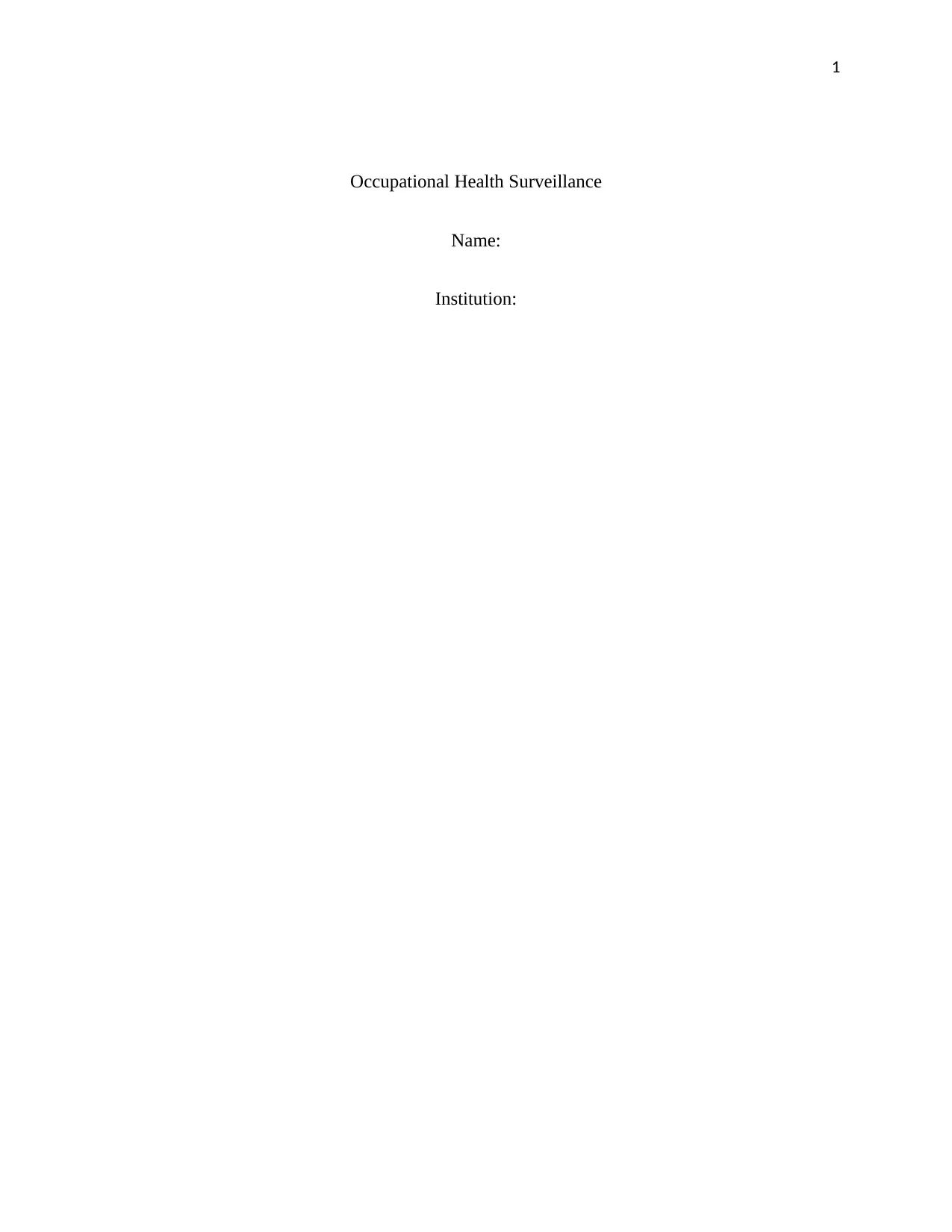
1
Occupational Health Surveillance
Name:
Institution:
Occupational Health Surveillance
Name:
Institution:
Paraphrase This Document
Need a fresh take? Get an instant paraphrase of this document with our AI Paraphraser
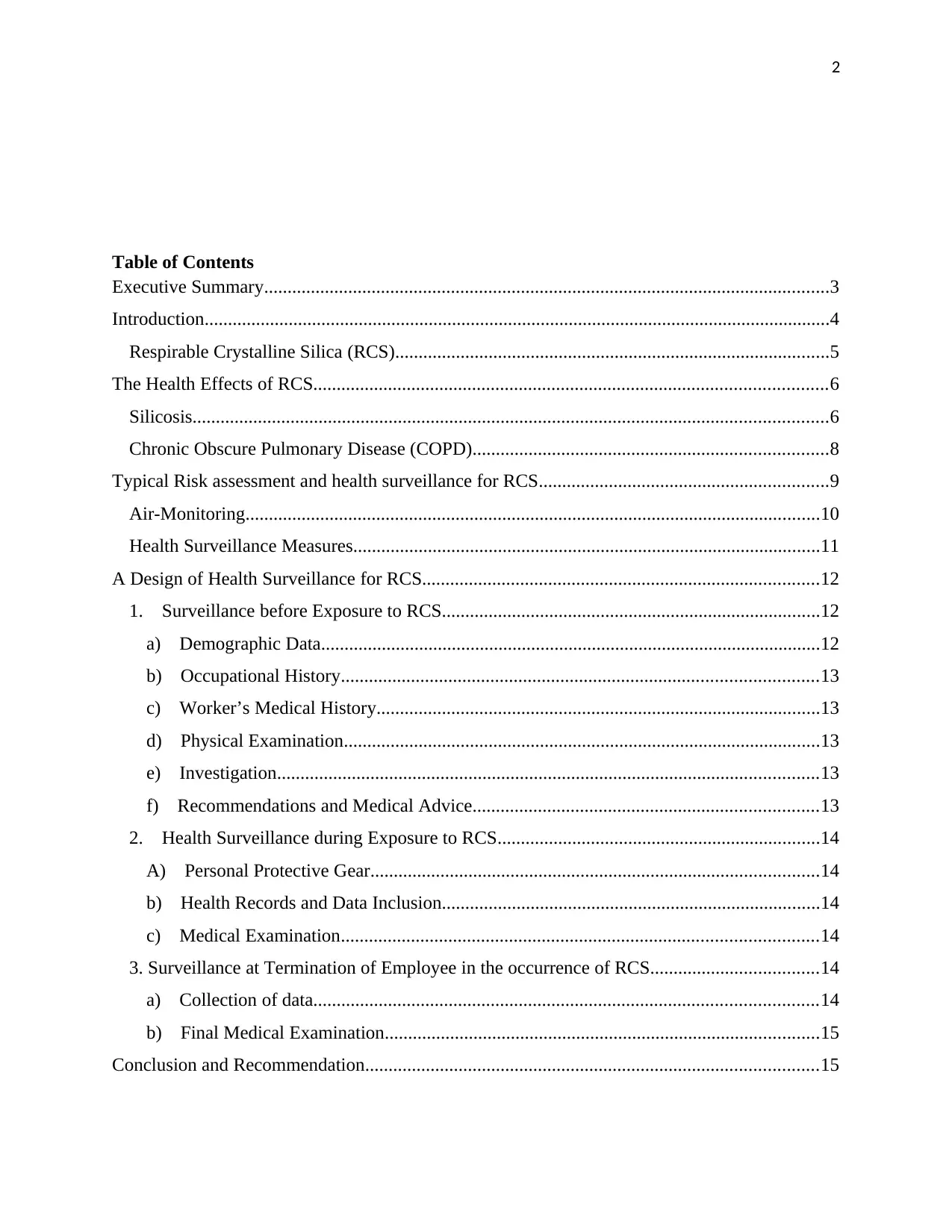
2
Table of Contents
Executive Summary.........................................................................................................................3
Introduction......................................................................................................................................4
Respirable Crystalline Silica (RCS).............................................................................................5
The Health Effects of RCS..............................................................................................................6
Silicosis........................................................................................................................................6
Chronic Obscure Pulmonary Disease (COPD)............................................................................8
Typical Risk assessment and health surveillance for RCS..............................................................9
Air-Monitoring...........................................................................................................................10
Health Surveillance Measures....................................................................................................11
A Design of Health Surveillance for RCS.....................................................................................12
1. Surveillance before Exposure to RCS.................................................................................12
a) Demographic Data...........................................................................................................12
b) Occupational History......................................................................................................13
c) Worker’s Medical History...............................................................................................13
d) Physical Examination......................................................................................................13
e) Investigation....................................................................................................................13
f) Recommendations and Medical Advice..........................................................................13
2. Health Surveillance during Exposure to RCS.....................................................................14
A) Personal Protective Gear................................................................................................14
b) Health Records and Data Inclusion.................................................................................14
c) Medical Examination......................................................................................................14
3. Surveillance at Termination of Employee in the occurrence of RCS....................................14
a) Collection of data............................................................................................................14
b) Final Medical Examination.............................................................................................15
Conclusion and Recommendation.................................................................................................15
Table of Contents
Executive Summary.........................................................................................................................3
Introduction......................................................................................................................................4
Respirable Crystalline Silica (RCS).............................................................................................5
The Health Effects of RCS..............................................................................................................6
Silicosis........................................................................................................................................6
Chronic Obscure Pulmonary Disease (COPD)............................................................................8
Typical Risk assessment and health surveillance for RCS..............................................................9
Air-Monitoring...........................................................................................................................10
Health Surveillance Measures....................................................................................................11
A Design of Health Surveillance for RCS.....................................................................................12
1. Surveillance before Exposure to RCS.................................................................................12
a) Demographic Data...........................................................................................................12
b) Occupational History......................................................................................................13
c) Worker’s Medical History...............................................................................................13
d) Physical Examination......................................................................................................13
e) Investigation....................................................................................................................13
f) Recommendations and Medical Advice..........................................................................13
2. Health Surveillance during Exposure to RCS.....................................................................14
A) Personal Protective Gear................................................................................................14
b) Health Records and Data Inclusion.................................................................................14
c) Medical Examination......................................................................................................14
3. Surveillance at Termination of Employee in the occurrence of RCS....................................14
a) Collection of data............................................................................................................14
b) Final Medical Examination.............................................................................................15
Conclusion and Recommendation.................................................................................................15
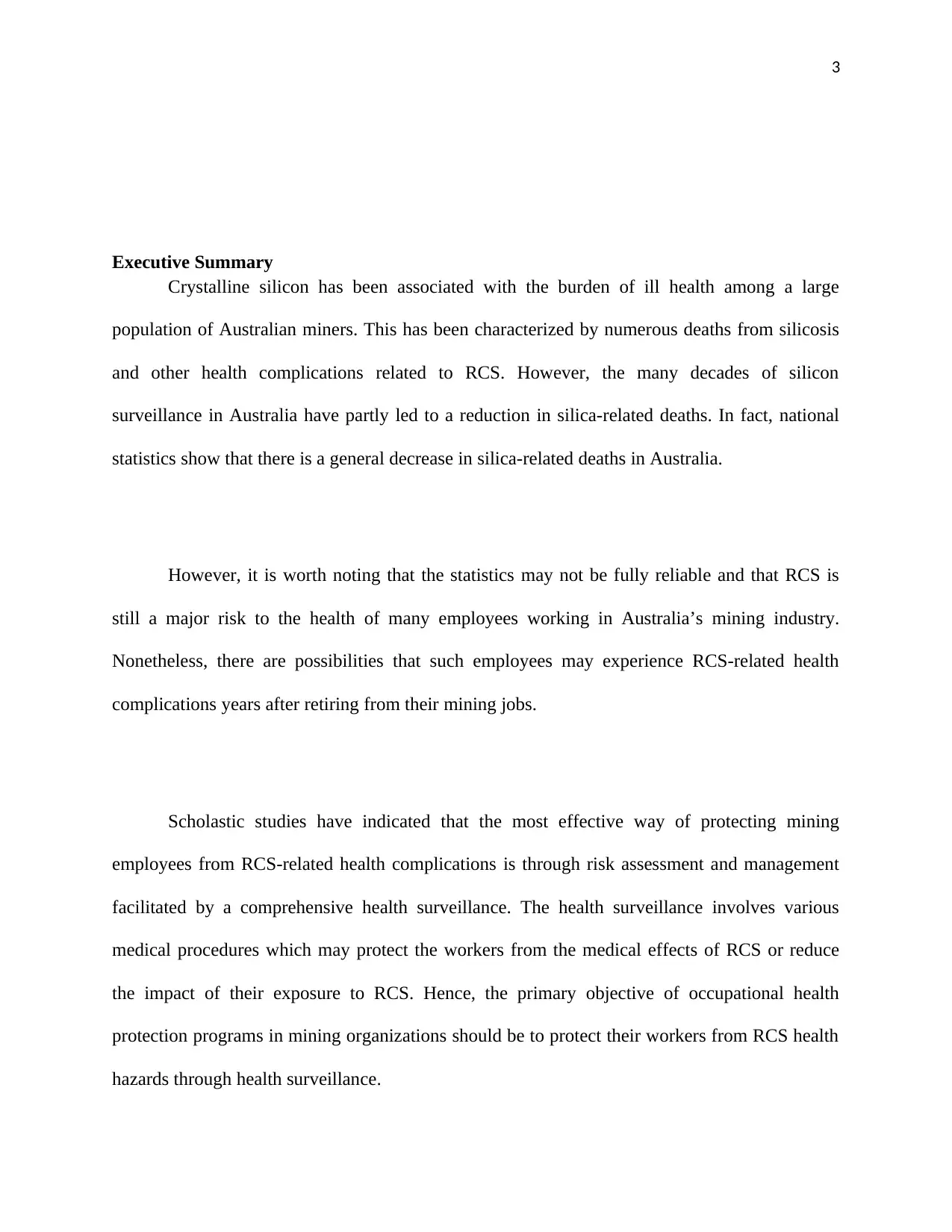
3
Executive Summary
Crystalline silicon has been associated with the burden of ill health among a large
population of Australian miners. This has been characterized by numerous deaths from silicosis
and other health complications related to RCS. However, the many decades of silicon
surveillance in Australia have partly led to a reduction in silica-related deaths. In fact, national
statistics show that there is a general decrease in silica-related deaths in Australia.
However, it is worth noting that the statistics may not be fully reliable and that RCS is
still a major risk to the health of many employees working in Australia’s mining industry.
Nonetheless, there are possibilities that such employees may experience RCS-related health
complications years after retiring from their mining jobs.
Scholastic studies have indicated that the most effective way of protecting mining
employees from RCS-related health complications is through risk assessment and management
facilitated by a comprehensive health surveillance. The health surveillance involves various
medical procedures which may protect the workers from the medical effects of RCS or reduce
the impact of their exposure to RCS. Hence, the primary objective of occupational health
protection programs in mining organizations should be to protect their workers from RCS health
hazards through health surveillance.
Executive Summary
Crystalline silicon has been associated with the burden of ill health among a large
population of Australian miners. This has been characterized by numerous deaths from silicosis
and other health complications related to RCS. However, the many decades of silicon
surveillance in Australia have partly led to a reduction in silica-related deaths. In fact, national
statistics show that there is a general decrease in silica-related deaths in Australia.
However, it is worth noting that the statistics may not be fully reliable and that RCS is
still a major risk to the health of many employees working in Australia’s mining industry.
Nonetheless, there are possibilities that such employees may experience RCS-related health
complications years after retiring from their mining jobs.
Scholastic studies have indicated that the most effective way of protecting mining
employees from RCS-related health complications is through risk assessment and management
facilitated by a comprehensive health surveillance. The health surveillance involves various
medical procedures which may protect the workers from the medical effects of RCS or reduce
the impact of their exposure to RCS. Hence, the primary objective of occupational health
protection programs in mining organizations should be to protect their workers from RCS health
hazards through health surveillance.
⊘ This is a preview!⊘
Do you want full access?
Subscribe today to unlock all pages.

Trusted by 1+ million students worldwide
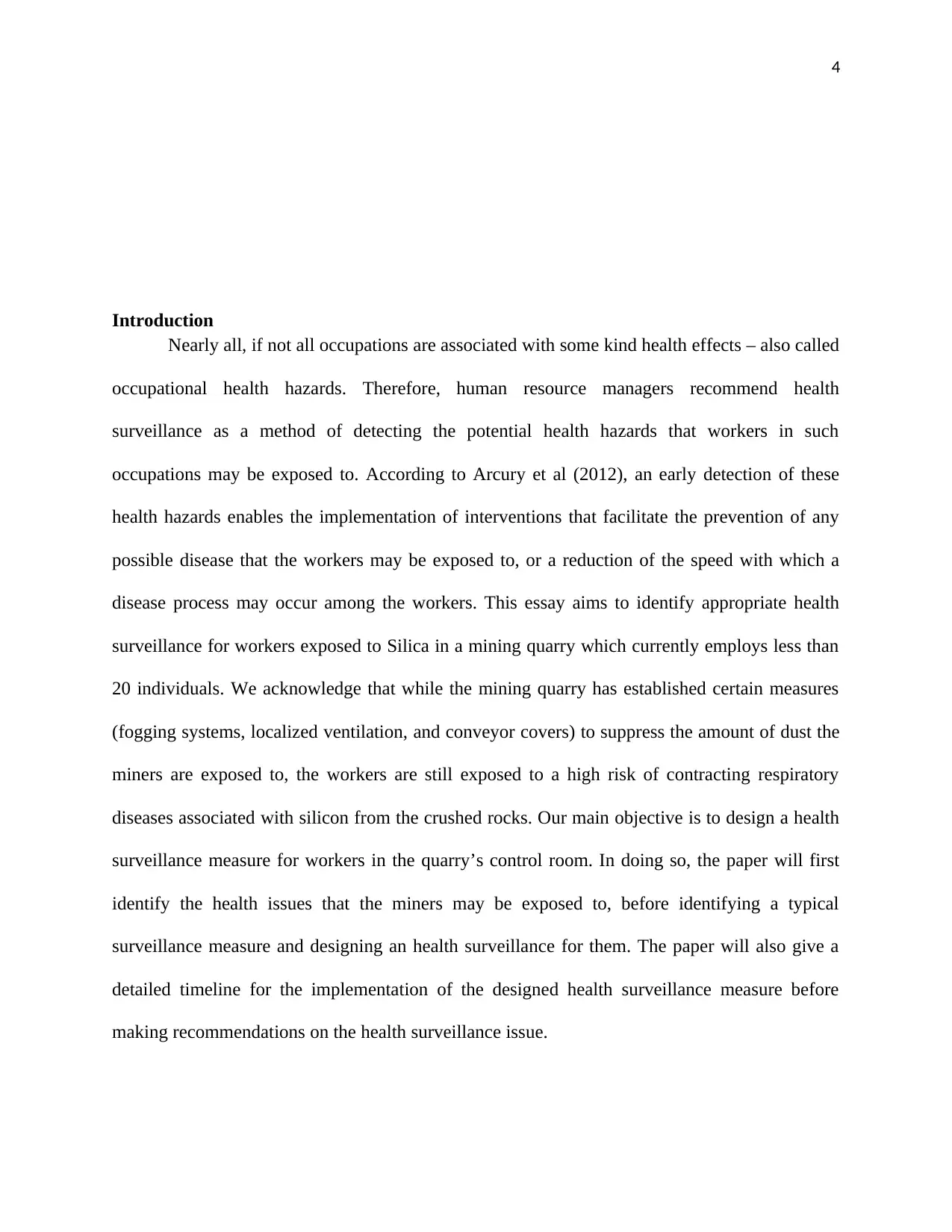
4
Introduction
Nearly all, if not all occupations are associated with some kind health effects – also called
occupational health hazards. Therefore, human resource managers recommend health
surveillance as a method of detecting the potential health hazards that workers in such
occupations may be exposed to. According to Arcury et al (2012), an early detection of these
health hazards enables the implementation of interventions that facilitate the prevention of any
possible disease that the workers may be exposed to, or a reduction of the speed with which a
disease process may occur among the workers. This essay aims to identify appropriate health
surveillance for workers exposed to Silica in a mining quarry which currently employs less than
20 individuals. We acknowledge that while the mining quarry has established certain measures
(fogging systems, localized ventilation, and conveyor covers) to suppress the amount of dust the
miners are exposed to, the workers are still exposed to a high risk of contracting respiratory
diseases associated with silicon from the crushed rocks. Our main objective is to design a health
surveillance measure for workers in the quarry’s control room. In doing so, the paper will first
identify the health issues that the miners may be exposed to, before identifying a typical
surveillance measure and designing an health surveillance for them. The paper will also give a
detailed timeline for the implementation of the designed health surveillance measure before
making recommendations on the health surveillance issue.
Introduction
Nearly all, if not all occupations are associated with some kind health effects – also called
occupational health hazards. Therefore, human resource managers recommend health
surveillance as a method of detecting the potential health hazards that workers in such
occupations may be exposed to. According to Arcury et al (2012), an early detection of these
health hazards enables the implementation of interventions that facilitate the prevention of any
possible disease that the workers may be exposed to, or a reduction of the speed with which a
disease process may occur among the workers. This essay aims to identify appropriate health
surveillance for workers exposed to Silica in a mining quarry which currently employs less than
20 individuals. We acknowledge that while the mining quarry has established certain measures
(fogging systems, localized ventilation, and conveyor covers) to suppress the amount of dust the
miners are exposed to, the workers are still exposed to a high risk of contracting respiratory
diseases associated with silicon from the crushed rocks. Our main objective is to design a health
surveillance measure for workers in the quarry’s control room. In doing so, the paper will first
identify the health issues that the miners may be exposed to, before identifying a typical
surveillance measure and designing an health surveillance for them. The paper will also give a
detailed timeline for the implementation of the designed health surveillance measure before
making recommendations on the health surveillance issue.
Paraphrase This Document
Need a fresh take? Get an instant paraphrase of this document with our AI Paraphraser
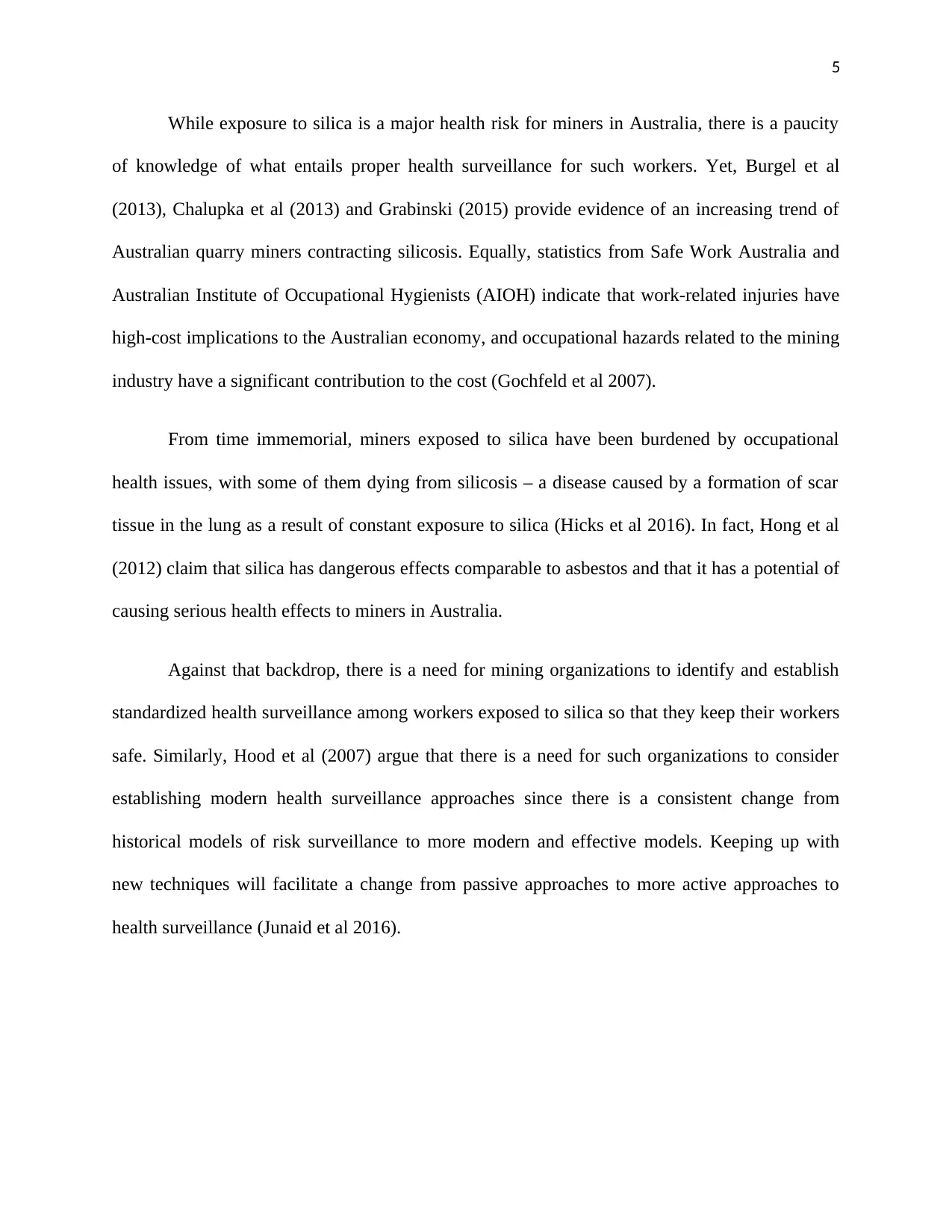
5
While exposure to silica is a major health risk for miners in Australia, there is a paucity
of knowledge of what entails proper health surveillance for such workers. Yet, Burgel et al
(2013), Chalupka et al (2013) and Grabinski (2015) provide evidence of an increasing trend of
Australian quarry miners contracting silicosis. Equally, statistics from Safe Work Australia and
Australian Institute of Occupational Hygienists (AIOH) indicate that work-related injuries have
high-cost implications to the Australian economy, and occupational hazards related to the mining
industry have a significant contribution to the cost (Gochfeld et al 2007).
From time immemorial, miners exposed to silica have been burdened by occupational
health issues, with some of them dying from silicosis – a disease caused by a formation of scar
tissue in the lung as a result of constant exposure to silica (Hicks et al 2016). In fact, Hong et al
(2012) claim that silica has dangerous effects comparable to asbestos and that it has a potential of
causing serious health effects to miners in Australia.
Against that backdrop, there is a need for mining organizations to identify and establish
standardized health surveillance among workers exposed to silica so that they keep their workers
safe. Similarly, Hood et al (2007) argue that there is a need for such organizations to consider
establishing modern health surveillance approaches since there is a consistent change from
historical models of risk surveillance to more modern and effective models. Keeping up with
new techniques will facilitate a change from passive approaches to more active approaches to
health surveillance (Junaid et al 2016).
While exposure to silica is a major health risk for miners in Australia, there is a paucity
of knowledge of what entails proper health surveillance for such workers. Yet, Burgel et al
(2013), Chalupka et al (2013) and Grabinski (2015) provide evidence of an increasing trend of
Australian quarry miners contracting silicosis. Equally, statistics from Safe Work Australia and
Australian Institute of Occupational Hygienists (AIOH) indicate that work-related injuries have
high-cost implications to the Australian economy, and occupational hazards related to the mining
industry have a significant contribution to the cost (Gochfeld et al 2007).
From time immemorial, miners exposed to silica have been burdened by occupational
health issues, with some of them dying from silicosis – a disease caused by a formation of scar
tissue in the lung as a result of constant exposure to silica (Hicks et al 2016). In fact, Hong et al
(2012) claim that silica has dangerous effects comparable to asbestos and that it has a potential of
causing serious health effects to miners in Australia.
Against that backdrop, there is a need for mining organizations to identify and establish
standardized health surveillance among workers exposed to silica so that they keep their workers
safe. Similarly, Hood et al (2007) argue that there is a need for such organizations to consider
establishing modern health surveillance approaches since there is a consistent change from
historical models of risk surveillance to more modern and effective models. Keeping up with
new techniques will facilitate a change from passive approaches to more active approaches to
health surveillance (Junaid et al 2016).

6
Respirable Crystalline Silica (RCS)
A major component of granite, sand, rock, soil and other minerals found in the earth’s
crust, crystalline silica dangerous substance consisting of silicon and oxygen (McCillagh et al
2012). The author further comments that silica may exist freely or combined with other elements
to form silicates. On the same note, McCauley et al (2012) indicate that the three common types
of crystalline silica (tridymite, cristobalite, and quartz) produce dangerous particles when
ground, drilled or cut; and that exposure to these particles (especially during mining) is a major
health hazard.
In Australia, exposure to RCS has been assigned a safety limit of 0.1 milligrams per
cubic meter (0.1mg/m3), meaning that an exposure beyond that limit would be considered a
health hazard (Maghsoudipour & Sarfaraz 2011). While some scholars claim that this limit is
low, Pak et al (2013) observe that part of the reason why the limit was set at that point is the
declining incidences of silicosis in Australia. However, the author mentions that despite a decline
in incidences of silicosis in Australia, exposure to RCS generally has adverse health effects on
most Australian miners. All in all, considering our case study, an RCS exposure of 0.15mg/m3
for primary operators and 0.51mg/m3 for secondary operator indicates a high health hazard
which needs immediate attention.
The Health Hazards of RCS
There is established evidence that RCS may expose miners to lung cancer, pulmonary
tuberculosis, silicosis and chronic obstructive pulmonary disease.
Silicosis
Silicosis is part of a group of dust-related diseases called pneumoconiosis, majorly
characterized by non-malignant and non-neoplastic changes in lungs as a result of exposure to
Respirable Crystalline Silica (RCS)
A major component of granite, sand, rock, soil and other minerals found in the earth’s
crust, crystalline silica dangerous substance consisting of silicon and oxygen (McCillagh et al
2012). The author further comments that silica may exist freely or combined with other elements
to form silicates. On the same note, McCauley et al (2012) indicate that the three common types
of crystalline silica (tridymite, cristobalite, and quartz) produce dangerous particles when
ground, drilled or cut; and that exposure to these particles (especially during mining) is a major
health hazard.
In Australia, exposure to RCS has been assigned a safety limit of 0.1 milligrams per
cubic meter (0.1mg/m3), meaning that an exposure beyond that limit would be considered a
health hazard (Maghsoudipour & Sarfaraz 2011). While some scholars claim that this limit is
low, Pak et al (2013) observe that part of the reason why the limit was set at that point is the
declining incidences of silicosis in Australia. However, the author mentions that despite a decline
in incidences of silicosis in Australia, exposure to RCS generally has adverse health effects on
most Australian miners. All in all, considering our case study, an RCS exposure of 0.15mg/m3
for primary operators and 0.51mg/m3 for secondary operator indicates a high health hazard
which needs immediate attention.
The Health Hazards of RCS
There is established evidence that RCS may expose miners to lung cancer, pulmonary
tuberculosis, silicosis and chronic obstructive pulmonary disease.
Silicosis
Silicosis is part of a group of dust-related diseases called pneumoconiosis, majorly
characterized by non-malignant and non-neoplastic changes in lungs as a result of exposure to
⊘ This is a preview!⊘
Do you want full access?
Subscribe today to unlock all pages.

Trusted by 1+ million students worldwide
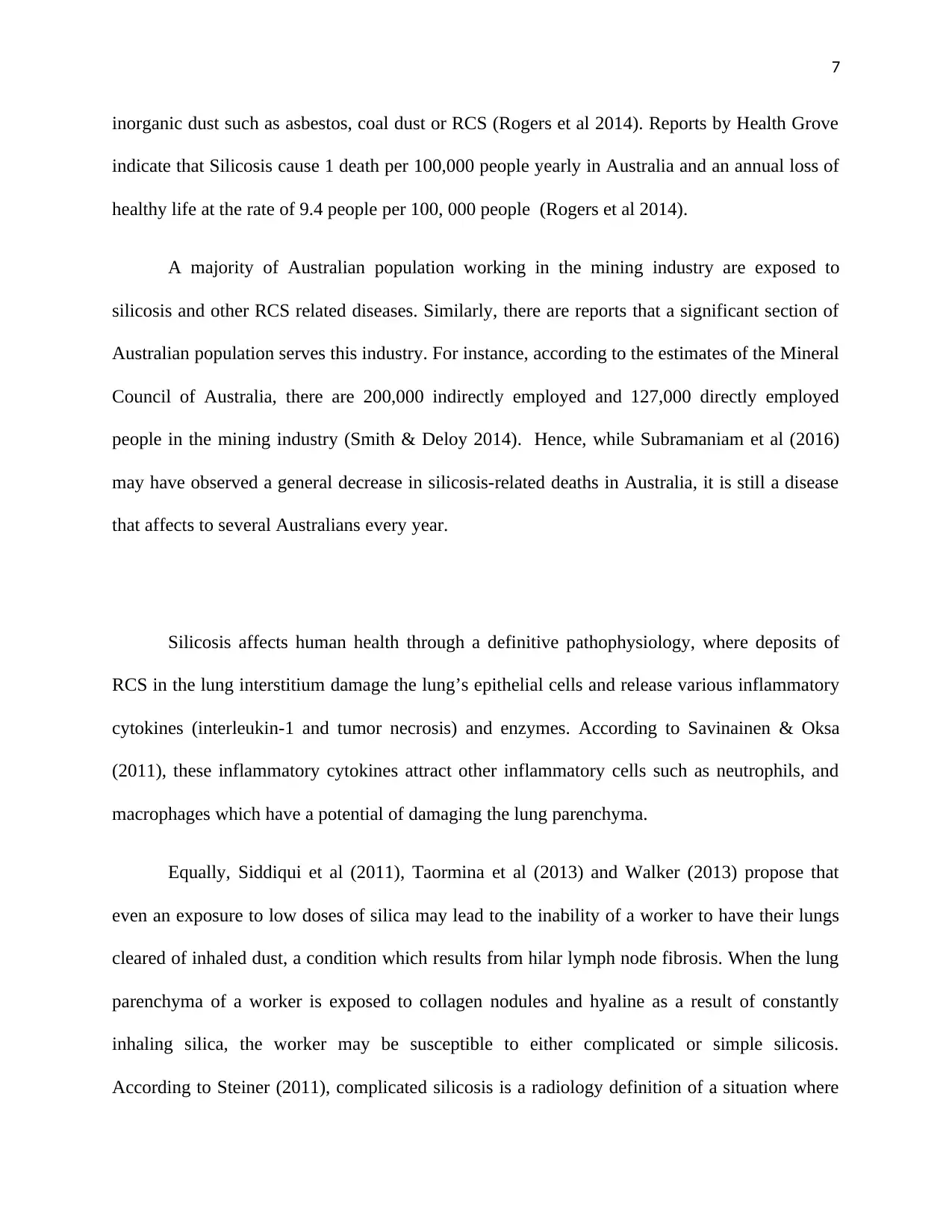
7
inorganic dust such as asbestos, coal dust or RCS (Rogers et al 2014). Reports by Health Grove
indicate that Silicosis cause 1 death per 100,000 people yearly in Australia and an annual loss of
healthy life at the rate of 9.4 people per 100, 000 people (Rogers et al 2014).
A majority of Australian population working in the mining industry are exposed to
silicosis and other RCS related diseases. Similarly, there are reports that a significant section of
Australian population serves this industry. For instance, according to the estimates of the Mineral
Council of Australia, there are 200,000 indirectly employed and 127,000 directly employed
people in the mining industry (Smith & Deloy 2014). Hence, while Subramaniam et al (2016)
may have observed a general decrease in silicosis-related deaths in Australia, it is still a disease
that affects to several Australians every year.
Silicosis affects human health through a definitive pathophysiology, where deposits of
RCS in the lung interstitium damage the lung’s epithelial cells and release various inflammatory
cytokines (interleukin-1 and tumor necrosis) and enzymes. According to Savinainen & Oksa
(2011), these inflammatory cytokines attract other inflammatory cells such as neutrophils, and
macrophages which have a potential of damaging the lung parenchyma.
Equally, Siddiqui et al (2011), Taormina et al (2013) and Walker (2013) propose that
even an exposure to low doses of silica may lead to the inability of a worker to have their lungs
cleared of inhaled dust, a condition which results from hilar lymph node fibrosis. When the lung
parenchyma of a worker is exposed to collagen nodules and hyaline as a result of constantly
inhaling silica, the worker may be susceptible to either complicated or simple silicosis.
According to Steiner (2011), complicated silicosis is a radiology definition of a situation where
inorganic dust such as asbestos, coal dust or RCS (Rogers et al 2014). Reports by Health Grove
indicate that Silicosis cause 1 death per 100,000 people yearly in Australia and an annual loss of
healthy life at the rate of 9.4 people per 100, 000 people (Rogers et al 2014).
A majority of Australian population working in the mining industry are exposed to
silicosis and other RCS related diseases. Similarly, there are reports that a significant section of
Australian population serves this industry. For instance, according to the estimates of the Mineral
Council of Australia, there are 200,000 indirectly employed and 127,000 directly employed
people in the mining industry (Smith & Deloy 2014). Hence, while Subramaniam et al (2016)
may have observed a general decrease in silicosis-related deaths in Australia, it is still a disease
that affects to several Australians every year.
Silicosis affects human health through a definitive pathophysiology, where deposits of
RCS in the lung interstitium damage the lung’s epithelial cells and release various inflammatory
cytokines (interleukin-1 and tumor necrosis) and enzymes. According to Savinainen & Oksa
(2011), these inflammatory cytokines attract other inflammatory cells such as neutrophils, and
macrophages which have a potential of damaging the lung parenchyma.
Equally, Siddiqui et al (2011), Taormina et al (2013) and Walker (2013) propose that
even an exposure to low doses of silica may lead to the inability of a worker to have their lungs
cleared of inhaled dust, a condition which results from hilar lymph node fibrosis. When the lung
parenchyma of a worker is exposed to collagen nodules and hyaline as a result of constantly
inhaling silica, the worker may be susceptible to either complicated or simple silicosis.
According to Steiner (2011), complicated silicosis is a radiology definition of a situation where
Paraphrase This Document
Need a fresh take? Get an instant paraphrase of this document with our AI Paraphraser
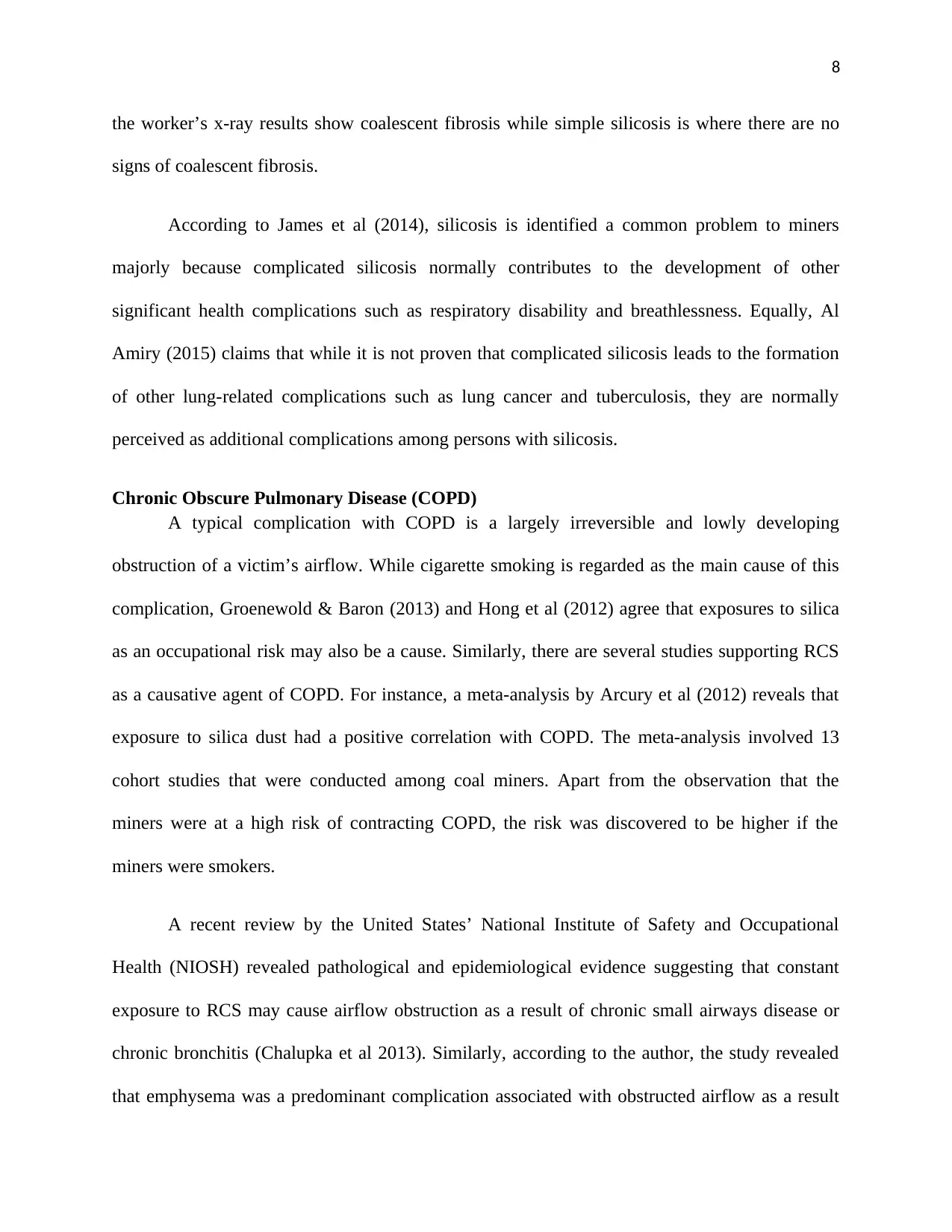
8
the worker’s x-ray results show coalescent fibrosis while simple silicosis is where there are no
signs of coalescent fibrosis.
According to James et al (2014), silicosis is identified a common problem to miners
majorly because complicated silicosis normally contributes to the development of other
significant health complications such as respiratory disability and breathlessness. Equally, Al
Amiry (2015) claims that while it is not proven that complicated silicosis leads to the formation
of other lung-related complications such as lung cancer and tuberculosis, they are normally
perceived as additional complications among persons with silicosis.
Chronic Obscure Pulmonary Disease (COPD)
A typical complication with COPD is a largely irreversible and lowly developing
obstruction of a victim’s airflow. While cigarette smoking is regarded as the main cause of this
complication, Groenewold & Baron (2013) and Hong et al (2012) agree that exposures to silica
as an occupational risk may also be a cause. Similarly, there are several studies supporting RCS
as a causative agent of COPD. For instance, a meta-analysis by Arcury et al (2012) reveals that
exposure to silica dust had a positive correlation with COPD. The meta-analysis involved 13
cohort studies that were conducted among coal miners. Apart from the observation that the
miners were at a high risk of contracting COPD, the risk was discovered to be higher if the
miners were smokers.
A recent review by the United States’ National Institute of Safety and Occupational
Health (NIOSH) revealed pathological and epidemiological evidence suggesting that constant
exposure to RCS may cause airflow obstruction as a result of chronic small airways disease or
chronic bronchitis (Chalupka et al 2013). Similarly, according to the author, the study revealed
that emphysema was a predominant complication associated with obstructed airflow as a result
the worker’s x-ray results show coalescent fibrosis while simple silicosis is where there are no
signs of coalescent fibrosis.
According to James et al (2014), silicosis is identified a common problem to miners
majorly because complicated silicosis normally contributes to the development of other
significant health complications such as respiratory disability and breathlessness. Equally, Al
Amiry (2015) claims that while it is not proven that complicated silicosis leads to the formation
of other lung-related complications such as lung cancer and tuberculosis, they are normally
perceived as additional complications among persons with silicosis.
Chronic Obscure Pulmonary Disease (COPD)
A typical complication with COPD is a largely irreversible and lowly developing
obstruction of a victim’s airflow. While cigarette smoking is regarded as the main cause of this
complication, Groenewold & Baron (2013) and Hong et al (2012) agree that exposures to silica
as an occupational risk may also be a cause. Similarly, there are several studies supporting RCS
as a causative agent of COPD. For instance, a meta-analysis by Arcury et al (2012) reveals that
exposure to silica dust had a positive correlation with COPD. The meta-analysis involved 13
cohort studies that were conducted among coal miners. Apart from the observation that the
miners were at a high risk of contracting COPD, the risk was discovered to be higher if the
miners were smokers.
A recent review by the United States’ National Institute of Safety and Occupational
Health (NIOSH) revealed pathological and epidemiological evidence suggesting that constant
exposure to RCS may cause airflow obstruction as a result of chronic small airways disease or
chronic bronchitis (Chalupka et al 2013). Similarly, according to the author, the study revealed
that emphysema was a predominant complication associated with obstructed airflow as a result

9
of exposure to RCS. Hence, we can summarise that RCS can cause chronic bronchitis or
emphysema which can result in airflow obstruction.
A review of studies in the Britain on the evidence of increased exposure to COPD in
industries and occupations such as tunnelling, cement production, ceramic production, pottery
and steel and iron founding, and gold mining found that a consistent exposure to silica in these
kinds of environments exposed the workers to COPD as a result of silica exposure (Chalupka et
al 2013).
RCS is also said to be a causative agent of rheumatoid silicotic nodules which are often
found on the lungs of miners and are a risk factor for lung cancer (Gochfeld et al 2007).
Similarly, according to Hicks et al (2016), the International Agency for Research on Cancer
(IARC) reveals RCS as a potential carcinogen for human lungs, although there has been a major
debate whether silica rather than silicosis is the most important causative agent for lung cancer.
Other major health complications associated with RCS include renal and autoimmune diseases.
Similarly, according to Burgel et al (2013), RCS has largely been reported to have a causative
relationship with systematic lupus erythematosus, sarcoidosis, scieroderma and rheumatoid
arthritis.
Typical Risk assessment and health surveillance for RCS
A typical way of conducting a risk surveillance of RCS exposure is through a
measurement of the airborne concentration. According to Hong et al (2012), this method is
appropriate because RCS only becomes a health risk when it is inhaled. Hence, In Australia, the
most common methodology of conducting a surveillance of RCS health risk is air-monitoring.
of exposure to RCS. Hence, we can summarise that RCS can cause chronic bronchitis or
emphysema which can result in airflow obstruction.
A review of studies in the Britain on the evidence of increased exposure to COPD in
industries and occupations such as tunnelling, cement production, ceramic production, pottery
and steel and iron founding, and gold mining found that a consistent exposure to silica in these
kinds of environments exposed the workers to COPD as a result of silica exposure (Chalupka et
al 2013).
RCS is also said to be a causative agent of rheumatoid silicotic nodules which are often
found on the lungs of miners and are a risk factor for lung cancer (Gochfeld et al 2007).
Similarly, according to Hicks et al (2016), the International Agency for Research on Cancer
(IARC) reveals RCS as a potential carcinogen for human lungs, although there has been a major
debate whether silica rather than silicosis is the most important causative agent for lung cancer.
Other major health complications associated with RCS include renal and autoimmune diseases.
Similarly, according to Burgel et al (2013), RCS has largely been reported to have a causative
relationship with systematic lupus erythematosus, sarcoidosis, scieroderma and rheumatoid
arthritis.
Typical Risk assessment and health surveillance for RCS
A typical way of conducting a risk surveillance of RCS exposure is through a
measurement of the airborne concentration. According to Hong et al (2012), this method is
appropriate because RCS only becomes a health risk when it is inhaled. Hence, In Australia, the
most common methodology of conducting a surveillance of RCS health risk is air-monitoring.
⊘ This is a preview!⊘
Do you want full access?
Subscribe today to unlock all pages.

Trusted by 1+ million students worldwide
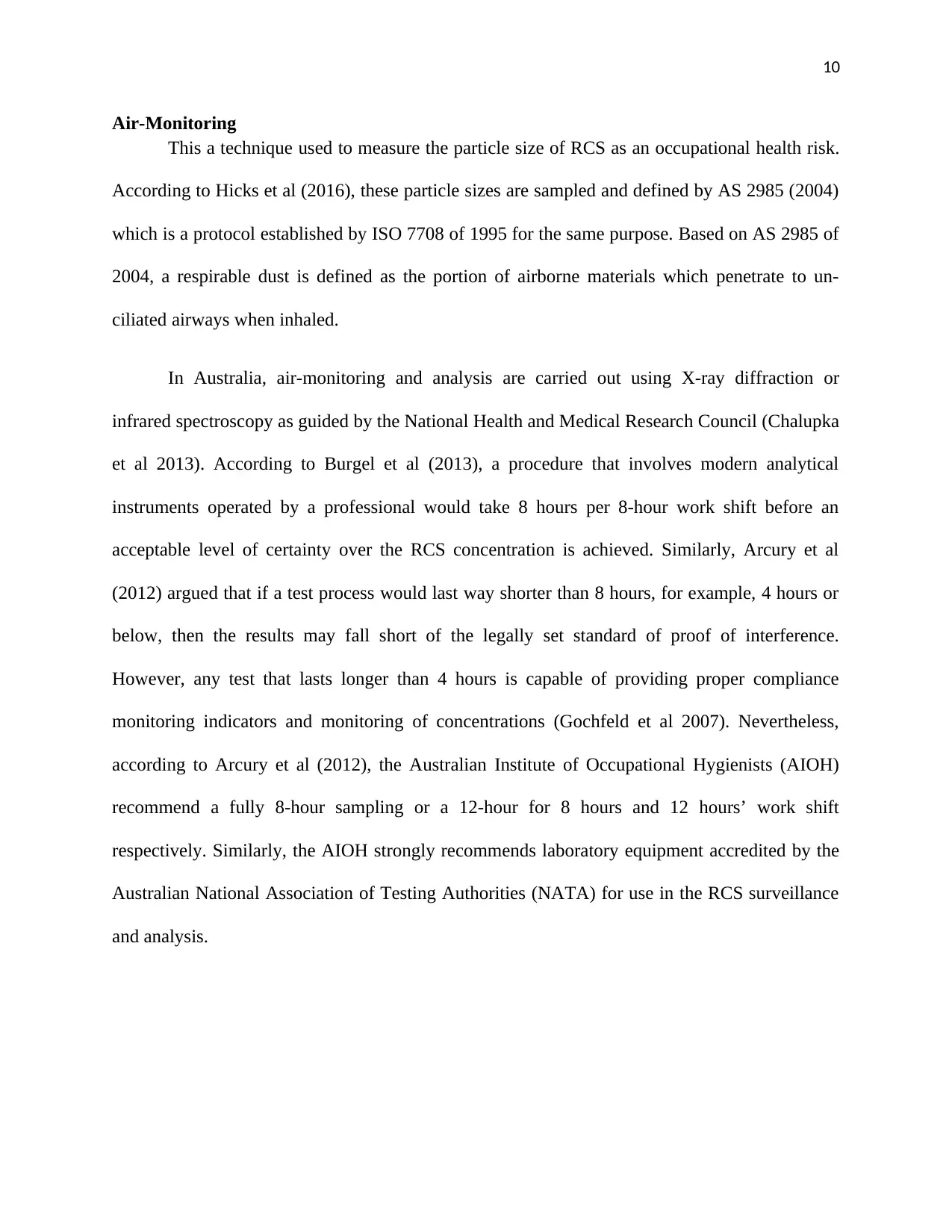
10
Air-Monitoring
This a technique used to measure the particle size of RCS as an occupational health risk.
According to Hicks et al (2016), these particle sizes are sampled and defined by AS 2985 (2004)
which is a protocol established by ISO 7708 of 1995 for the same purpose. Based on AS 2985 of
2004, a respirable dust is defined as the portion of airborne materials which penetrate to un-
ciliated airways when inhaled.
In Australia, air-monitoring and analysis are carried out using X-ray diffraction or
infrared spectroscopy as guided by the National Health and Medical Research Council (Chalupka
et al 2013). According to Burgel et al (2013), a procedure that involves modern analytical
instruments operated by a professional would take 8 hours per 8-hour work shift before an
acceptable level of certainty over the RCS concentration is achieved. Similarly, Arcury et al
(2012) argued that if a test process would last way shorter than 8 hours, for example, 4 hours or
below, then the results may fall short of the legally set standard of proof of interference.
However, any test that lasts longer than 4 hours is capable of providing proper compliance
monitoring indicators and monitoring of concentrations (Gochfeld et al 2007). Nevertheless,
according to Arcury et al (2012), the Australian Institute of Occupational Hygienists (AIOH)
recommend a fully 8-hour sampling or a 12-hour for 8 hours and 12 hours’ work shift
respectively. Similarly, the AIOH strongly recommends laboratory equipment accredited by the
Australian National Association of Testing Authorities (NATA) for use in the RCS surveillance
and analysis.
Air-Monitoring
This a technique used to measure the particle size of RCS as an occupational health risk.
According to Hicks et al (2016), these particle sizes are sampled and defined by AS 2985 (2004)
which is a protocol established by ISO 7708 of 1995 for the same purpose. Based on AS 2985 of
2004, a respirable dust is defined as the portion of airborne materials which penetrate to un-
ciliated airways when inhaled.
In Australia, air-monitoring and analysis are carried out using X-ray diffraction or
infrared spectroscopy as guided by the National Health and Medical Research Council (Chalupka
et al 2013). According to Burgel et al (2013), a procedure that involves modern analytical
instruments operated by a professional would take 8 hours per 8-hour work shift before an
acceptable level of certainty over the RCS concentration is achieved. Similarly, Arcury et al
(2012) argued that if a test process would last way shorter than 8 hours, for example, 4 hours or
below, then the results may fall short of the legally set standard of proof of interference.
However, any test that lasts longer than 4 hours is capable of providing proper compliance
monitoring indicators and monitoring of concentrations (Gochfeld et al 2007). Nevertheless,
according to Arcury et al (2012), the Australian Institute of Occupational Hygienists (AIOH)
recommend a fully 8-hour sampling or a 12-hour for 8 hours and 12 hours’ work shift
respectively. Similarly, the AIOH strongly recommends laboratory equipment accredited by the
Australian National Association of Testing Authorities (NATA) for use in the RCS surveillance
and analysis.
Paraphrase This Document
Need a fresh take? Get an instant paraphrase of this document with our AI Paraphraser
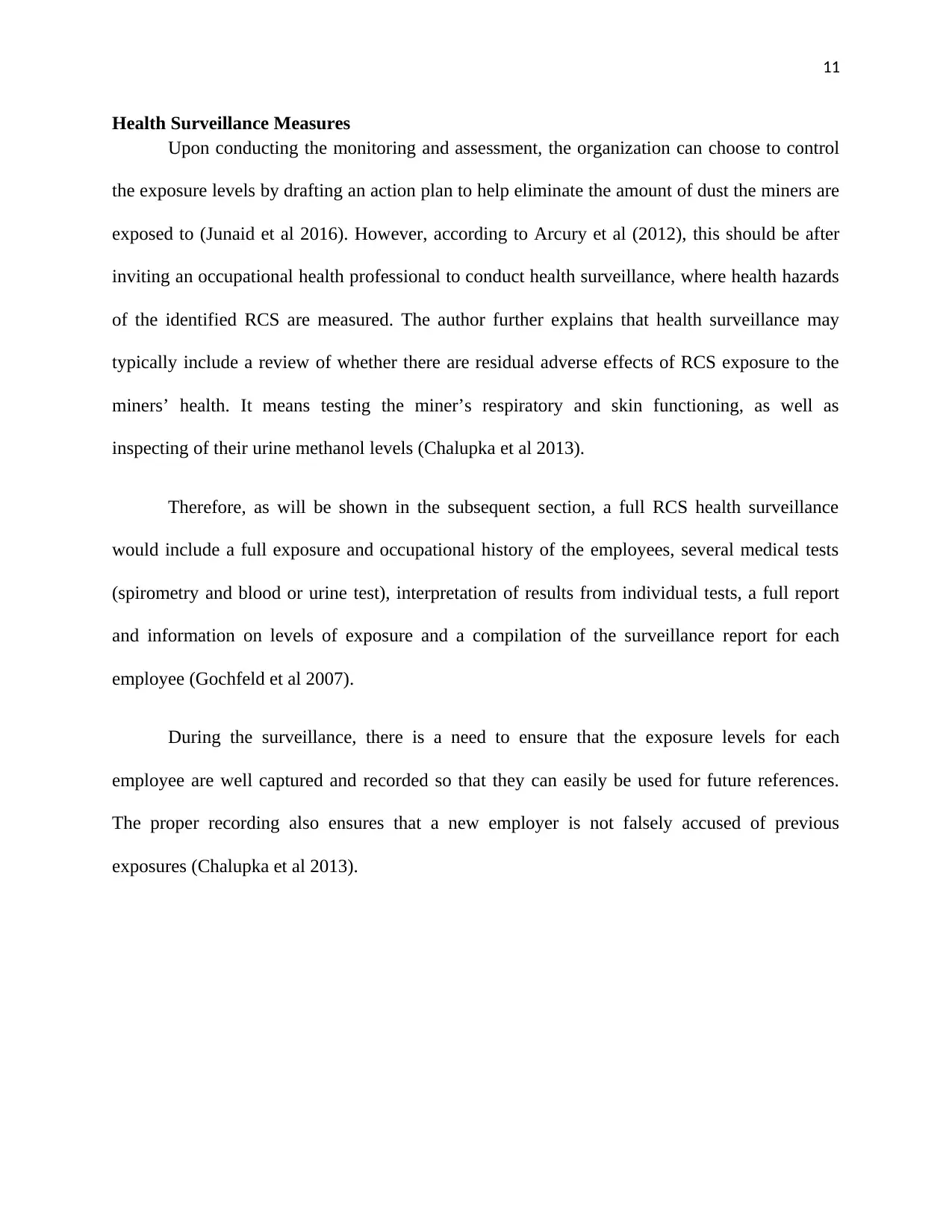
11
Health Surveillance Measures
Upon conducting the monitoring and assessment, the organization can choose to control
the exposure levels by drafting an action plan to help eliminate the amount of dust the miners are
exposed to (Junaid et al 2016). However, according to Arcury et al (2012), this should be after
inviting an occupational health professional to conduct health surveillance, where health hazards
of the identified RCS are measured. The author further explains that health surveillance may
typically include a review of whether there are residual adverse effects of RCS exposure to the
miners’ health. It means testing the miner’s respiratory and skin functioning, as well as
inspecting of their urine methanol levels (Chalupka et al 2013).
Therefore, as will be shown in the subsequent section, a full RCS health surveillance
would include a full exposure and occupational history of the employees, several medical tests
(spirometry and blood or urine test), interpretation of results from individual tests, a full report
and information on levels of exposure and a compilation of the surveillance report for each
employee (Gochfeld et al 2007).
During the surveillance, there is a need to ensure that the exposure levels for each
employee are well captured and recorded so that they can easily be used for future references.
The proper recording also ensures that a new employer is not falsely accused of previous
exposures (Chalupka et al 2013).
Health Surveillance Measures
Upon conducting the monitoring and assessment, the organization can choose to control
the exposure levels by drafting an action plan to help eliminate the amount of dust the miners are
exposed to (Junaid et al 2016). However, according to Arcury et al (2012), this should be after
inviting an occupational health professional to conduct health surveillance, where health hazards
of the identified RCS are measured. The author further explains that health surveillance may
typically include a review of whether there are residual adverse effects of RCS exposure to the
miners’ health. It means testing the miner’s respiratory and skin functioning, as well as
inspecting of their urine methanol levels (Chalupka et al 2013).
Therefore, as will be shown in the subsequent section, a full RCS health surveillance
would include a full exposure and occupational history of the employees, several medical tests
(spirometry and blood or urine test), interpretation of results from individual tests, a full report
and information on levels of exposure and a compilation of the surveillance report for each
employee (Gochfeld et al 2007).
During the surveillance, there is a need to ensure that the exposure levels for each
employee are well captured and recorded so that they can easily be used for future references.
The proper recording also ensures that a new employer is not falsely accused of previous
exposures (Chalupka et al 2013).
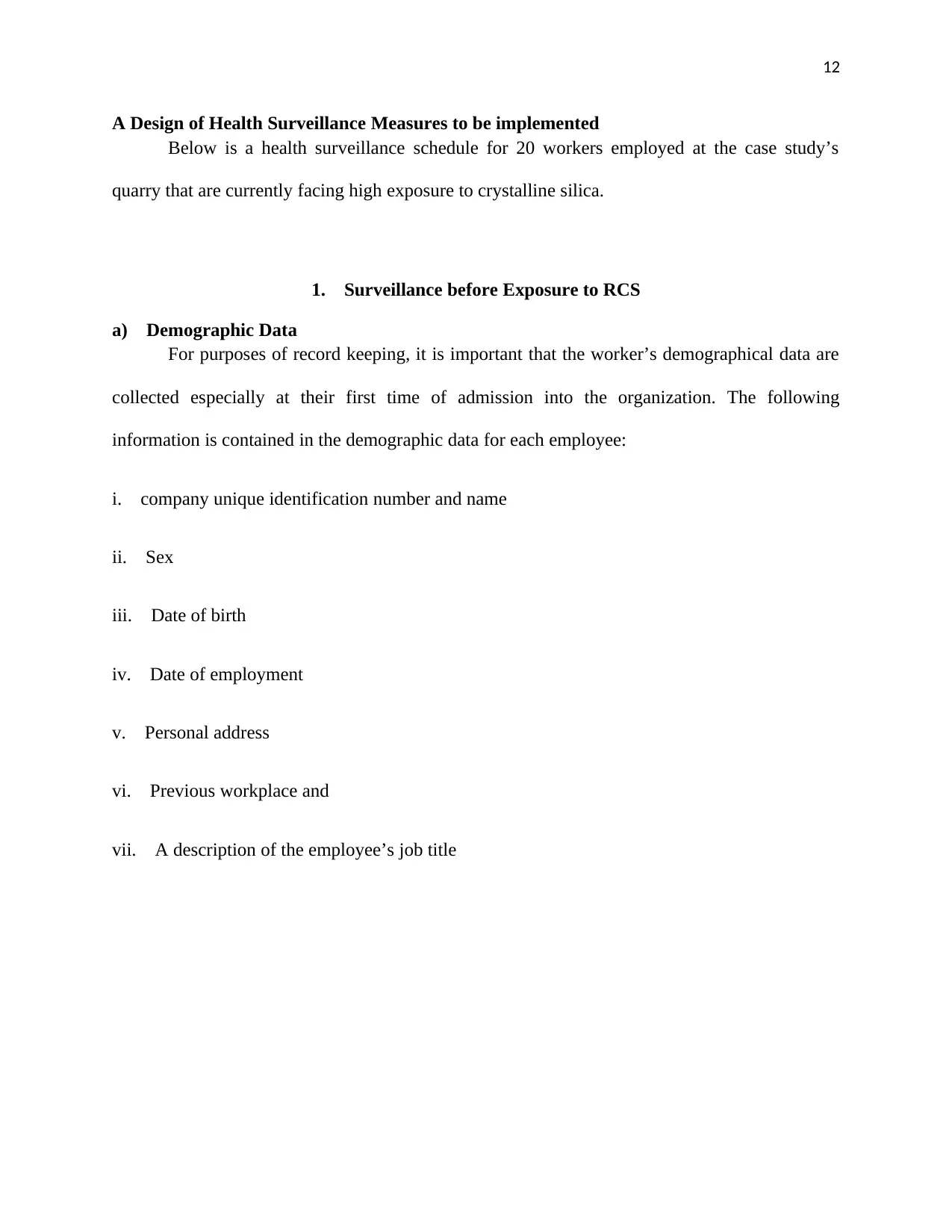
12
A Design of Health Surveillance Measures to be implemented
Below is a health surveillance schedule for 20 workers employed at the case study’s
quarry that are currently facing high exposure to crystalline silica.
1. Surveillance before Exposure to RCS
a) Demographic Data
For purposes of record keeping, it is important that the worker’s demographical data are
collected especially at their first time of admission into the organization. The following
information is contained in the demographic data for each employee:
i. company unique identification number and name
ii. Sex
iii. Date of birth
iv. Date of employment
v. Personal address
vi. Previous workplace and
vii. A description of the employee’s job title
A Design of Health Surveillance Measures to be implemented
Below is a health surveillance schedule for 20 workers employed at the case study’s
quarry that are currently facing high exposure to crystalline silica.
1. Surveillance before Exposure to RCS
a) Demographic Data
For purposes of record keeping, it is important that the worker’s demographical data are
collected especially at their first time of admission into the organization. The following
information is contained in the demographic data for each employee:
i. company unique identification number and name
ii. Sex
iii. Date of birth
iv. Date of employment
v. Personal address
vi. Previous workplace and
vii. A description of the employee’s job title
⊘ This is a preview!⊘
Do you want full access?
Subscribe today to unlock all pages.

Trusted by 1+ million students worldwide
1 out of 21
Related Documents
Your All-in-One AI-Powered Toolkit for Academic Success.
+13062052269
info@desklib.com
Available 24*7 on WhatsApp / Email
![[object Object]](/_next/static/media/star-bottom.7253800d.svg)
Unlock your academic potential
Copyright © 2020–2025 A2Z Services. All Rights Reserved. Developed and managed by ZUCOL.




![Air Pollution & Health: Silica Dust Effects - [University Name] Report](/_next/image/?url=https%3A%2F%2Fdesklib.com%2Fmedia%2Fsilica-dust-effects_page_2.jpg&w=256&q=75)
